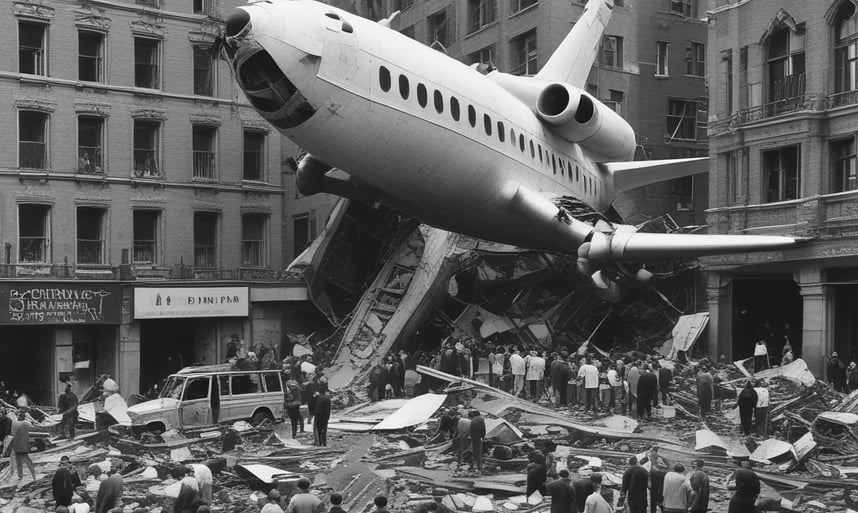Air India Dreamliner Crashes After Takeoff, Killing 241: Worst Aviation Disaster in Years
LATEST


A devastating tragedy struck on Thursday as an Air India Boeing 787 Dreamliner crashed moments after takeoff from Ahmedabad’s Sardar Vallabhbhai Patel International Airport, killing 241 of the 242 people on board. It marks the first-ever crash of a Boeing 787 Dreamliner and the deadliest plane crash in recent years.
First Boeing 787 Crash Claims 241 Lives
The aircraft, bound for London, lost signal just seconds after departure. According to flight-tracking service Flightradar24, the plane reached a maximum altitude of only 625 feet before plummeting and bursting into flames in a densely populated residential area. The airport’s elevation is approximately 200 feet, meaning the plane barely gained 400 feet of altitude.
Only one person on board survived, according to officials. Several casualties on the ground have also been reported.
The Aircraft: A Boeing 787-8 Dreamliner
The downed aircraft was a Boeing 787-8 Dreamliner, a long-haul twin-aisle jet widely used by international carriers. This particular plane had completed its first flight in December 2013 and joined Air India’s fleet in January 2014. As of Thursday, Air India operated 34 Dreamliners, with plans to acquire at least 20 more.
Globally, there are over 1,100 Dreamliners currently in service.
Unclear Cause: Plane Lost Altitude Quickly
Preliminary data indicate that the aircraft suffered catastrophic failure less than one minute after takeoff. The reason for the sudden descent remains unknown. Investigators emphasize that air crashes are often caused by multiple converging factors, including mechanical failure, pilot error, or external conditions like weather or bird strikes.
Video footage of the aircraft’s takeoff is being reviewed, and early reports suggest the jet struggled to gain altitude before crashing.
What Will Investigators Look For?
Authorities are searching the wreckage for the aircraft’s black boxes — the cockpit voice recorder and the flight data recorder — which are critical to understanding the final moments of the flight.
Investigators will examine:
The plane’s maintenance and service history
The pilots’ training, health, and recent rest periods
Mechanical systems, including slats and flaps
External conditions, such as temperature and wind
Surveillance footage and eyewitness accounts
India’s Directorate General of Civil Aviation (DGCA) is leading the investigation, in collaboration with Boeing, GE Aerospace (which makes the plane’s engines), and U.S. crash investigators under international aviation protocols.
Previous Issues with the Dreamliner
Although there have been past concerns over Dreamliner manufacturing and quality control, experts say it is too early to connect those issues to Thursday’s crash.
“This doesn’t immediately look like a manufacturing defect,” said Jeff Guzzetti, a former U.S. National Transportation Safety Board investigator. “It appears the airplane got off the runway with no problem but was unable to climb.”
Boeing has faced multiple quality issues in the past:
A 2023 whistleblower accused Boeing of taking shortcuts that created stress in major aircraft joints.
In 2021–2022, deliveries of the Dreamliner were suspended due to fuselage gaps.
In 2013, early Dreamliners were grounded due to concerns about lithium battery fires.
Boeing’s Broader Safety Record Under Scrutiny
The crash adds to ongoing scrutiny of Boeing’s safety and manufacturing standards. The company is still recovering from the fallout of two fatal 737 Max crashes in 2018 and 2019, and the blowout of a door plug on a Max 9 in January 2024.
Since taking over in August 2024, Boeing CEO Kelly Ortberg has sought to stabilize the company’s operations. Thursday’s crash may hinder those efforts.
A note from Wolfe Research suggested the financial impact may be limited in the short term but could delay Boeing’s momentum. “We don’t see much direct impact on financial performance,” the analysts wrote. “But this is certain to sap momentum until some solid clarity is provided.”
Impact on Orders and Production
As of now, Boeing has nearly 900 Dreamliners on order worldwide. Industry experts expect airlines to continue placing orders despite the tragedy, citing the long lead time for aircraft delivery. Wolfe Research added that there’s no expected change to the production ramp or significant impact on demand at this time.
However, potential delays in certifying Boeing’s 777X, which has not yet received full regulatory approval, could arise depending on the findings of the crash investigation.
Air India’s Ambitious Modernization Plans in Jeopardy
Air India, under new management and ownership by Tata Group, has been aggressively modernizing its fleet with high-end aircraft from Boeing and Airbus. The airline had positioned the Dreamliner as a key part of its international expansion and premium service push.
Thursday’s crash could pose a significant setback to those plans, not only because of the aircraft loss but also due to reputational damage and potential regulatory reviews.
Global Implications for Aviation Safety
Beyond Air India and Boeing, the crash raises fresh concerns about aviation safety in the era of increasingly complex, computer-assisted aircraft. Dreamliners are among the most advanced passenger jets, incorporating carbon-composite materials, digital avionics, and high-efficiency engines.
Safety regulators and airlines worldwide will closely watch the investigation for any signs of systemic issues. With nearly 1,100 Dreamliners in the skies, any findings related to design or performance could have global consequences.
